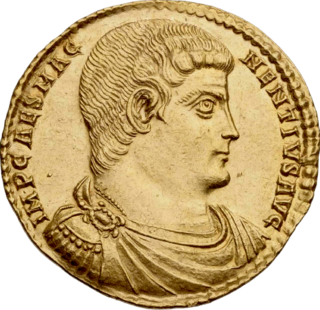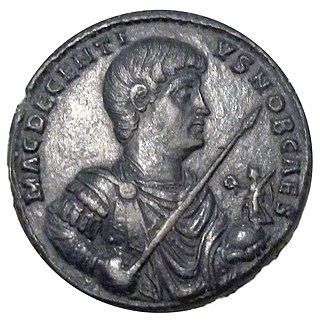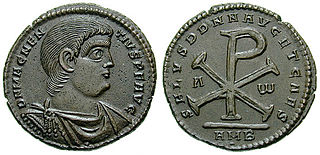Related Research Articles

Constantius II was Roman emperor from 337 to 361. His reign saw constant warfare on the borders against the Sasanian Empire and Germanic peoples, while internally the Roman Empire went through repeated civil wars, court intrigues, and usurpations. His religious policies inflamed domestic conflicts that would continue after his death.

Flavius Julius Constans, also called Constans I, was Roman emperor from 337 to 350. He held the imperial rank of caesar from 333, and was the youngest son of Constantine the Great.

Julian was the Caesar of the West from 355 to 360 and Roman emperor from 361 to 363, as well as a notable philosopher and author in Greek. His rejection of Christianity, and his promotion of Neoplatonic Hellenism in its place, caused him to be remembered as Julian the Apostate in Christian tradition. He is sometimes referred to as Julian the Philosopher.
The 350s decade ran from January 1, 350, to December 31, 359.

Year 357 (CCCLVII) was a common year starting on Wednesday of the Julian calendar. At the time, it was known as the Year of the Consulship of Constantius and Iulianus. The denomination 357 for this year has been used since the early medieval period, when the Anno Domini calendar era became the prevalent method in Europe for naming years.

Valentinian I, sometimes called Valentinian the Great, was Roman emperor from 364 to 375. He ruled the Western half of the empire, while his brother Valens ruled the East. During his reign, he fought successfully against the Alamanni, Quadi, and Sarmatians, strengthening the border fortifications and conducting campaigns across the Rhine and Danube. His general Theodosius defeated a revolt in Africa and the Great Conspiracy, a coordinated assault on Roman Britain by Picts, Scoti, and Saxons. Valentinian founded the Valentinianic dynasty, with his sons Gratian and Valentinian II succeeding him in the western half of the empire.

Magnus Magnentius was a Roman general and usurper against Constantius II. Of Germanic descent, Magnentius served with distinction in Gaul under the emperor Constans. On 18 January 350 Magnentius was acclaimed Augustus. Quickly killing the unpopular Constans, Magnentius gained control over most of the Western Empire. The Eastern emperor Constantius II, the brother of Constans, refused to acknowledge Magnentius' legitimacy and led a successful campaign against Magnentius. Ultimately, Magnentius' forces were scattered after the Battle of Mons Seleucus, and he died by suicide on 10 August 353.

This is a chronology of warfare between the Romans and various Germanic peoples. The nature of these wars varied through time between Roman conquest, Germanic uprisings, later Germanic invasions of the Western Roman Empire that started in the late second century BC, and more. The series of conflicts was one factor which led to the ultimate downfall of the Western Roman Empire in particular and ancient Rome in general in 476.

The siege of Amida was a military investment of the Roman fortified frontier city of Amida by the Sasanian Empire. It took place in AD 359 when the Sasanian army under king Shapur II invaded the eastern provinces of the Roman Empire. Shapur wanted to exploit the absence of the Roman Emperor Constantius II who was overseeing affairs in the western part of the Empire. The city fell, but the strategic gain was little.
The Battle of Mursa was fought on 28 September 351 between the eastern Roman armies led by the Emperor Constantius II and the western forces supporting the usurper Magnentius. It took place at Mursa, near the Via Militaris in the province of Pannonia. The battle, one of the bloodiest in Roman history, was a pyrrhic victory for Constantius.

The Battle of Lingones was fought in 298 between the Western Roman Empire and the Alamanni. The Roman force was led by Constantius Chlorus, and was victorious.
The Battle of Strasbourg also known as the Battle of Argentoratum was fought in 357 between the Western Roman army under Julian and the Alamanni tribal confederation led by the joint paramount King Chnodomar. The battle took place near Strasbourg, called Argentoratum in Ammianus Marcellinus' account, Argentorate in the Tabula Peutingeriana.

Magnus Decentius was caesar of the Western Roman Empire from 350 to 353, under his brother Magnentius.
Barbatio was a Roman general of the infantry under the command of Constantius II. Previously he was a commander of the household troops under Gallus Caesar, but he arrested Gallus under the instruction of Constantius, thereby ensuring his promotion on the death of Claudius Silvanus. In 359, both he and his wife Assyria were arrested and beheaded for treason against Constantius, possibly as part of a plot by Arbitio, a senior cavalry commander, and another exponent of the forms of scheming and political intrigue that became such a part of the later Roman Empire.

Helena was a Roman Empress by marriage to Julian, Roman emperor in 360–363. She was briefly his Empress consort when Julian was proclaimed Augustus by his troops in 360. She died prior to the resolution of his conflict with Constantius II.
Chnodomar was the king of an Alamannic canton in what is now south-west Germany, near the Rhine from sometime before 352 till 357. He seems to have had a recognized position among the other Alamanni.

The Roman civil war of 350–353 AD was a war fought between the Roman emperor Constantius II and the usurper Magnentius.

Byzantine Empire under the Constantinian and Valentinianic dynasties was the earliest period of the Byzantine history that saw a shift in government from Rome in the West to Constantinople in the East within the Roman Empire under emperor Constantine the Great and his successors. Constantinople, formally named Nova Roma, was founded in the city of Byzantium, which is the origin of the historiographical name for the Eastern Empire, which self-identified simply as the "Roman Empire".
Flavius Arintheus was a Roman army officer who started his career in the middle ranks and rose to senior political and military positions. He served the emperors Constantius II, Julian, Jovian and Valens. In 372 he was appointed consul, alongside Domitius Modestus.
The Perso-Roman wars of 337–361 were a series of military conflicts fought between the Roman Empire and the Sasanian Empire between 337 and 361. They were a result of long-standing competition between the rival powers over influence in the border kingdoms of Armenia and Iberia, as well as the desire of Shapur II, after his Arab campaign, to revoke the unfavorable terms of the Treaty of Nisibis, which had concluded the previous war between the empires. Though the Romans under Constantius II were defeated in several sanguinary encounters, Shapur was unable to secure a decisive victory.
References
- ↑ Edward Gibbon, The Decline And Fall Of The Roman Empire, (The Modern Library, 1932), chap. XVIII., p. 597
- ↑ Ammianus Marcellinus, The History, (Kindle Edition), XVI., 12, 5
- ↑ Gibbon, Ibid. chap. XIX., p. 622
- ↑ Ammianus, XV., 8, 1-21
- ↑ Ammianus, XVI., 2, 1
- ↑ Ammianus, XVI., 1, 5
- ↑ Ammianus, XVI., 2, 2
- ↑ Goldsworthy, Adrian. In the Name of Rome, Weidenfeld and Nicolson, 2003, p. 343